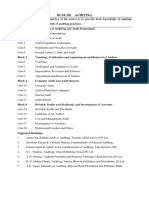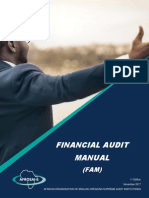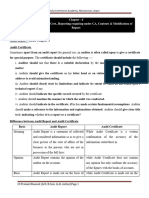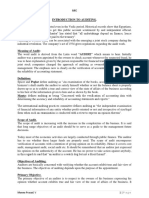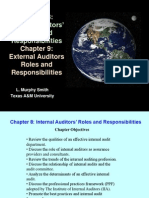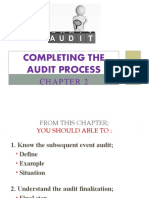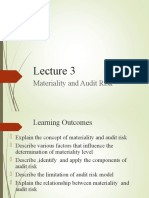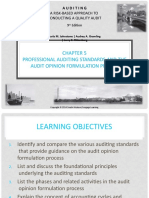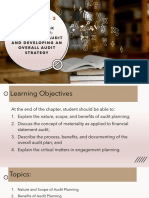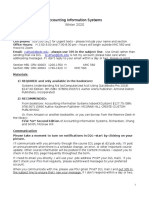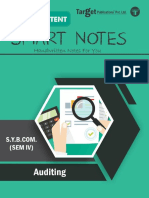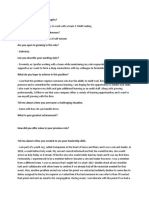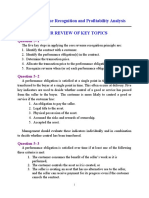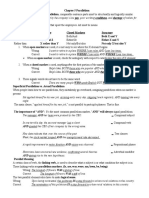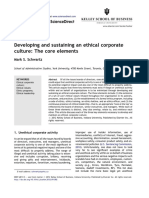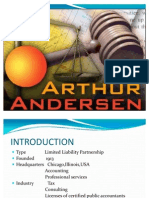Chapters Audit
Uploaded by
rudyChapters Audit
Uploaded by
rudywhi10847_fm.
qxd 6/17/05 11:55 PM Page i
Principles of
Auditing and
Other Assurance
Services
whi10847_fm.qxd 6/17/05 11:55 PM Page ii
whi10847_fm.qxd 6/17/05 11:55 PM Page iii
Principles of
Auditing and
Other Assurance
Services
Fifteenth Edition
O. Ray Whittington
CIA, CMA, CPA
DePaul University
Kurt Pany
CFE, CPA
Arizona State University
Boston Burr Ridge, IL Dubuque, IA Madison, WI New York San Francisco St. Louis
Bangkok Bogot Caracas Kuala Lumpur Lisbon London Madrid Mexico City
Milan Montreal New Delhi Santiago Seoul Singapore Sydney Taipei Toronto
whi10847_fm.qxd 6/17/05 11:55 PM Page iv
PRINCIPLES OF AUDITING AND OTHER ASSURANCE SERVICES
Published by McGraw-Hill/Irwin, a business unit of The McGraw-Hill Companies, Inc., 1221 Avenue of the
Americas, New York, NY, 10020. Copyright 2007, 2004, 2001, 1998, 1995, 1992, 1989, 1988, 1985, 1982, 1977,
1973, 1969, 1964, 1959, 1953 by The McGraw-Hill Companies, Inc. All rights reserved. No part of this publication
may be reproduced or distributed in any form or by any means, or stored in a database or retrieval system, without
the prior written consent of The McGraw-Hill Companies, Inc., including, but not limited to, in any network or
other electronic storage or transmission, or broadcast for distance learning.
Some ancillaries, including electronic and print components, may not be available to customers outside the
United States.
This book is printed on acid-free paper.
1 2 3 4 5 6 7 8 9 0 DOW/DOW 0 9 8 7 6 5
ISBN 0-07-301084-7
Editorial director: Brent Gordon
Publisher: Stewart Mattson
Executive editor: Tim Vertovec
Managing developmental editor: Gail Korosa
Marketing manager: Marc Chernoff
Media producer: Elizabeth Mavetz
Project manager: Dana M. Pauley
Production supervisor: Gina Hangos
Designer: Kami Carter
Senior media project manager: Rose M. Range
Senior supplement producer: Carol Loreth
Developer, Media technology: Brian Nacik
Cover design: Jenny El-Shamy
Interior design: Jenny El-Shamy
Typeface: 10/12 Times New Roman
Compositor: Interactive Composition Corporation
Printer: R. R. Donnelley
Library of Congress Cataloging-in-Publication Data
Whittington, Ray, 1948
Principles of auditing and other assurance services / O. Ray Whittington, Kurt Pany.
15th ed.
p. cm.
Includes index.
ISBN 0-07-301084-7 (alk. paper)
1. Auditing. I. Pany, Kurt. II. Title.
HF5667.W39 2006
657!.45dc22
2005049113
www.mhhe.com
whi10847_fm.qxd 6/17/05 11:55 PM Page v
About the Authors
O. Ray Whittington
O. Ray Whittington, CIA, CMA, CPA, serves as the Ledger and Quill Director of the School of
Accountancy at DePaul University. He received his B.B.A., M.S., and Ph.D. degrees from Sam
Houston State University, Texas Tech University, and the University of Houston, respectively.
Professor Whittington is an active textbook author on the subjects of auditing and audit sampling. He has also published in a variety of journals, including The Accounting Review, The
Journal of Accounting Research, and Auditing: A Journal of Practice and Theory. He has served
as a member of the Board of Regents of the Institute of Internal Auditors and has served as
Chairman on the Auditing Standards Committee of the Auditing Section and the Bylaws
Committee, both of the American Accounting Association. Professor Whittington was until
recently a member of the AICPA Auditing Standards Board, and currently he is the Presidentelect of the Auditing Section of the American Accounting Association.
Kurt Pany
Kurt Pany, CPA, CFE, is a Professor of Accounting at Arizona State University. He received his
B.S., M.B.A., and Ph.D. degrees from the University of Arizona, the University of Minnesota,
and the University of Illinois, respectively. He has also served as a staff accountant with Arthur
Andersen and Touche Ross, as a member of the Auditing Standards Board, and as an academic
fellow with the American Institute of Certified Public Accountants. Professor Pany has
published articles on auditing in such journals as The Journal of Accounting Research, The Accounting Review, Auditing: A Journal of Practice and Theory, The Journal of Accountancy, and
The CPA Journal. He is a member of and has served on various committees of the American
Accounting Association, the American Institute of Certified Public Accountants, and the
Arizona Society of Certified Public Accountants.
whi10847_fm.qxd 6/17/05 11:55 PM Page vi
whi10847_fm.qxd 6/17/05 11:55 PM Page vii
Preface
The past few years we have seen unprecedented changes in the auditing profession. These
changes were precipitated by the revelation that management of a number of large public companies, including Enron and WorldCom, systematically misstated the financial statements of
the companies over a number of years. As a result, we have witnessed congressional hearings
about the accounting profession, the criminal conviction and liquidation of the international
accounting firm of Arthur Andersen LLP, the passage of the Sarbanes-Oxley Act of 2002, and
the creation of the Public Company Accounting Oversight Board, which takes from the profession the major portion of its self-regulatory authority. The goal of the fifteenth edition of
Principles of Auditing and Other Assurance Services is to provide you with a clear perspective of this new auditing environment.
How do we do this?
1. Balanced presentation. This text provides a carefully balanced presentation of auditing
and assurance theory and practice. The concepts are written in a clear, concise, and understandable manner suitable for students who have not had significant audit experience. Real
company examples are integrated throughout the text to bring this material to life. Lastly,
Keystone Computers & Networks, Inc., the texts illustrative audit case, is integrated into
selected chapters, providing students with hands-on audit experience.
2. Clarifying the changes to the profession. The authors have included all the new legal and
standards changes affecting the auditing profession to provide students with the most
current and up-to-date auditing text available.
3. CPA Exam Support. The text includes both multiple choice questions and simulations
aimed at helping students pass the new computerized CPA exam.
4. Maintaining a clear perspective. The Online Learning Center provides instructors and
students with a wealth of material to help keep students up-to-date. The OLC receives daily
updates from The New York Times and McGraw-Hills PowerWeb so you always know the
breaking news affecting the profession. The OLC also contains quizzes and other resources
to help students in this course.
Just as the cover provides a clear perspective of the environment outside, Principles of Auditing and Other Assurance Services, 15/e, will provide students with a clear perspective of the
new auditing environment.
O. Ray Whittington
Kurt Pany
vii
whi10847_fm.qxd 6/17/05 11:55 PM Page viii
Key Features of the Book
Sarbanes-Oxley Act of 2002 and the resulting Public Company
Accounting Oversight Board profoundly affect public accountants,
CPA firms, and their clients. Most notably, the public accounting
profession is no longer largely self-regulating, CPAs must issue a
publicly available report on the internal control of each publicly traded
client, and top management must certify the companys financial
statements, and provide an assessment of internal control over financial
reporting. The text carefully integrates coverage of the acts nature and
effects on the profession in selected chapters. Also included is coverage
of financial frauds, such as those involving Enron and WorldCom,
which led to passage of the act.
The first 9 chapters of the text emphasize the
philosophy and environment of the profession,
with special attention paid to the nature and
economic purpose of auditing and assurance
services, professional standards, professional
conduct, legal liability, audit evidence, audit
planning, consideration of internal control,
audit sampling, audit documentation, and
general records.
Auditor legal liability in Chapter 4 is updated
based on suggestions by legal scholar
Professor Marianne Jennings of Arizona State
University.
Chapter 6 includes the dramatic changes
required by Statement on Auditing Standards
No. 99, The Auditors Consideration of Fraud
in a Financial Statement Audit.
Chapters 7 and 8 reflect the professions most
recent pronouncements relating to information
technology and internal control.
1. The Role of the Public Accountant in the
American Economy
2. Professional Standards
3. Professional Ethics
4. Legal Liability of CPAs
5. Audit Evidence and Documentation
6. Planning the Audit; Linking Audit Procedures
to Risk
7. Internal Control
8. Consideration of Internal Control in an Information
Technology Environment
9. Audit Sampling
whi10847_fm.qxd 6/17/05 11:55 PM Page ix
Keystone Computers & Networks, Inc., is the texts Illustrative
Audit Case. This feature has been updated in this edition and
illustrates audit methods and provides realistic, thought-provoking
case exercises. Although each portion of the case is designed to stand
alone, if used in combination, the case will help the student develop
problem-solving skills in planning (Chapter 6), in considering internal
control and testing account balances (Chapters 11 and 14), and in
completing the audit (Chapter 16). The case incorporates the use of
computerized accounting applications and also integrates the
fundamentals of audit sampling from Chapter 9.
10. Cash and Financial Investments
11. Accounts Receivable, Notes Receivable, and
Revenue
12. Inventories and Cost of Goods Sold
13. Property, Plant, and Equipment: Depreciation
and Depletion
14. Accounts Payable and Other Liabilities
15. Debt and Equity Capital
16. Auditing Operations and Completing the
Audit
17. Auditors Reports
18. Integrated Audits of Public Companies
19. Additional Assurance Services: Historical
Financial Information
20. Additional Assurance Services: Other
Information
21. Internal, Operational, and Compliance Auditing
International Auditing Standards are
discussed as appropriate. These standards
are becoming increasingly significant with
the development of international markets
for securities.
Chapters 10 through 16 (the procedural
chapters) deal with internal control and
obtaining evidence about the various financial
statement accounts; they emphasize a riskbased approach to selecting appropriate
auditing procedures. They also provide a
description of the business risk approach to
audits that has been adopted by many large
CPA firms and is the approach included in the
recently issued exposure draft of the proposed
Statement on Auditing Standards on Risk
Assessment. Chapters 10 through 16 also
thoroughly integrate the requirements of SAS
No. 99. Chapters 10, 11, 12, and 14 include a set
of interrelated simulations similar to those
included on the uniform CPA exam.
Chapter 17 presents the auditors reporting
responsibilities for audits of financial
statements for both public and nonpublic
companies.
Chapter 18, new to this edition, presents the
details of the audit of internal control over
financial reporting required for public
companies.
Chapter 19 covers special reports and reports
arising from accounting and review
engagements.
Chapter 20 presents a variety of attestation
and other assurance services. The material on
attestation services describes the current
professional standards. Other assurance
services are included at both a conceptual and
practical level.
Chapter 21s discussion of compliance auditing
has been modified based on the suggestions of
Mr. Norwood J. Jackson, former Deputy
Controller, Office of Federal Management, U.S.
Office of Management and Budget.
whi10847_fm.qxd 6/17/05 11:55 PM Page x
x Contents
NEW IN THIS EDITION
The Auditing & Attestation section of the Uniform Certified Public Accountant Exam represents 412 hours of that
14-hour examination. The AICPA indicates that each Auditing & Attestation exam will consist of multiple choice
questions and two condensed case studies referred to as simulations.
New to this edition, we have prepared four interrelated simulations. These simulations are comparable in
requirements to that provided by the AICPA and are included in the text itself. They are included in Chapters 10, 11, 12,
and 14. Three additional interrelated simulations on the texts Web site, www.mhhe.com/whittington15e: Two of the
simulations are available to students, and all three to instructors. Because they are MS Excel based, they do not require
the extensive computer downloads necessary for the AICPA simulation.
CPA Simulation
1050.
The following simulation has three parts:
Company profile
Industry information
Financial statements
Questions
The company profile, industry information, and financial statements are also used as the basis for
the simulations in Chapters 11, 12, and 14. Each of those chapters has a different set of questions.
Company profile:
In 20X1, Gary Sherwood founded Sherwood Stone Company (SSC). In the middle of its second year of existence, the company completed development of a large extraction pit area and
constructed an aggregate processing plant which is equipped to crush, screen, and wash aggregate products. By 20X4 the sand and gravel operation was profitable and growing market
conditions justified modifications and expansion. Currently, SSC produces a wide range of
sand and stone products from its pit near Bisbee, Arizona. The materials it develops are composed of sand and stone materials for commercial construction and highway projects.
SSC sells to a wide variety of commercial and governmental customers, with only one of
its numerous customersWingo Corporationaccounting for more than 5 percent of total
sales. In total, Wingo has represented approximately 30 percent of sales (and receivables) for
the past few years. Wingo Corporation is by far Arizonas largest street and road contractor and
Reviewers asked for multiple choice questions similar to those on the CPA exam. We have doubled the number of
this type of question in each chapter, and highlighted them in the problem material.
We have added a new chapter on integrated audits of public companies (Chapter 18) and have changed the
sequencing of the last chapters in the book.
Chapter 20 now includes coverage of internal auditing for Sarbanes-Oxley and the services that are performed by
internal auditors.
The book is now 2-color to help highlight material in the illustrations.
We have added subtitles to the Illustrative Cases for easy reference.
We now include numbered learning objectives at the beginning of each chapter and reference them within the
chapter.
Because fraud is such an important aspect of auditing today, weve included a logo wherever we talk about its
implications on the auditing process.
All of the text figures are now included on the Instructors Resource CD for easy classroom presentations.
The great volume of coverage included in the text make it ideal as the basis for not only a basic auditing course, but
also for a major portion of a second semester (or quarter) course included in either a four or five year program.
whi10847_fm.qxd 6/17/05 11:55 PM Page xi
FEATURES OF THIS EDITION
This text includes a variety of features to enhance the learning experience:
Illustrative Cases
Actual business and accounting examples are used
to illustrate key chapter concepts. The cases are
boxed and appear throughout the text. New cases
have been added for recent alleged audit failures.
They are now subtitled for easy reference.
Illustrative Case
Employment with Clients
The situation in which audit clients hire audit firm personnel
is difficult. On the one hand, it provides great professional
opportunities for individuals who enter the public accounting profession. On the other, independence concerns have
led to the restrictions presented in this section.
Questions were raised about the number of exArthur
Andersen employees hired by Enron Corporation prior to its
collapse (see Chapter 1). Although both firms refused to
disclose details, the positions and numbers of exArthur
Andersen employees hired by Enron seem significant. The
Wall Street Journal reported that Enron executives who had
previously worked with Arthur Andersen in auditing included its chief accounting officer, its chief financial officer,
and the vice president of corporate development. The
Washington Post indicated that, over the years Arthur
Andersen served as auditor, 86 employees left the firm and
accepted positions at Enron.
In addition, questions arose as to the nature of the relationship between continuing Arthur Andersen employees
and those of Enron. Again, The Wall Street Journal reported
that Arthur Andersen auditors and consultants shared in
office birthdays, frequented lunch-time parties in a nearby
park and participated in weekend fundraisers for charities.
They even went on Enron employees ski trips to Beaver
Creek, Colorado. One Enron employee suggested that
People just thought they were Enron employees . . . they
walked and talked the same way. Consistently, the Washington Post reported that the chief accounting officer was
the Arthur Andersen partners regular golfing buddy, and
that people at Enron referred to Andersen as Enron Prep.
Industry Focus Cases
These cases use examples from specific industries to
provide students with a detailed, real world
illustration of points being emphasized in the text.
These cases show the importance of having a
thorough knowledge of the audit clients business
and industry. Like the illustrative cases, these cases
are boxed and appear throughout the text.
Focus on the Airline Industry
Electronic ticketing has become basic to the airline industry. Under these systems a passenger may
book a flight over the telephone or by computer and be assigned a reservation number rather
than being issued a physical ticket. Since no ticket is created until the passenger checks in for the
flight, the auditor is limited in the extent to which he or she can examine paper support for
transactions. Accordingly, audit procedures must be developed relating to the associated revenues and receivables. Auditors often choose to test the computer controls in such situations.
xi
whi10847_fm.qxd 6/17/05 11:55 PM Page xii
Illustrative Documents
Sales
78644
PURCHASE ORDER
Pilot Stores
1425 G St.
Irvine, CA 92345
Documents included in the various procedural
chapters (Chapters 10 through 16) provide concise,
realistic examples of the documents associated
with the various transaction cycles. See the front
endpapers of this text for the complete figure.
Wood Supply Co.
To: ____________________
21 Main St.
____________________
Suisun, CA 95483
____________________
Nov. 10, 200X
Date: ____________________
Jon Trucking
Ship via: _________________
2/10, n/40
Terms: ____________
Enter our order for
Qty
20 doz.
10
Description
Price
Q Clamps
#26537489
120 hp
Generators
#45983748
$235.00
$4700.00
355.00
3550.00
Wood Supply Co.
7462537
Accounts
INVOICE
Wood Supply Co.
21 Main St.
Suisun City, CA 95483
Sales
8250.00
Pilot Stores
Sold to: _________________
1425 G St.
_________________
Irvine, CA 92345
_________________
Nov. 27, 200X
Date: ____________________
78644
Your order no.: ___________
Nov. 25, 200X
Shipped: _________________
Jon Trucking
Shipped via: ______________
Qty
Description
20 doz.
Q Clamps
10
120 hp
Generators
Price
Total
$235.00
$ 4700.00
355.00
3550.00
________
$ 8250.00
Accounts Receivable
8250.00
8250.00
Cash
Audit Objectives
The use of Audit Objectives is a basic tool in audit
program design. These help the auditor focus on
the reason a procedure is being done and provide a
check to assure that all management assertions in
the financial statements are audited.
ga
Learning Objective 6
Primary Audit
Objective:
Valuation
Primary Audit
Objectives:
Existence
Rights
xii
Total
o substa t ve tests o cas t a sact o s a d ba a ces.
C. Perform Substantive Tests of Cash Transactions and Balances.
1. Obtain Analyses of Cash Balances and Reconcile to the General Ledger.
The auditors will prepare or obtain a schedule that lists all of the clients cash accounts. For
cash in bank accounts, this schedule will typically list the bank, the account number, the
account type, and the year-end balance per books. The auditors will trace and reconcile all
accounts to the general ledger as necessary.
2. Send Standard Confirmation Forms to Financial Institutions to Verify Amounts
on Deposit.
One of the objectives of the auditors work on cash is to substantiate the existence of the
amount of cash shown on the balance sheet. A direct approach to this objective is to confirm
amounts on deposit and obtain or prepare reconciliations between bank statements and the
accounting records.
Bill Jones
By: ____________________
whi10847_fm.qxd 6/17/05 11:55 PM Page xiii
Illustrations, Tables, and Flowcharts
These are used throughout to enhance and clarify the presentation. In this edition, flowcharts have been color-coded
consistently to help students see and better understand the concepts.
Chapter Learning Objectives
These objectives provide a concise presentation of each
chapters most important concepts. They are now
numbered and referenced in the chapter.
Chapter learning objectives
After studying this chapter, you should be able to:
LO1. Describe the sources and nature of cash.
LO2. Identify the auditors objectives for the audit of cash.
LO3. Explain the nature of the cash receipts and disbursements cycles, and describe the
fundamental controls over the business processes related to cash.
LO4. Assess inherent and fraud risks for cash.
LO5. Assess control risk and design typical tests of controls used by auditors to support
the assessed levels of control risk for cash.
LO6. Explain how the auditors design substantive audit procedures and address the
risks of material misstatement of cash.
Key Terms Introduced or Emphasized in the Chapter
This is a glossary of each chapters most important terms. The terms are in color within the chapter and are defined at
the end of the chapter. Placing the definitions at the end of each chapter allows the student to quickly find the meaning
of unfamiliar terms while reading the material. The glossary also serves as an excellent review tool and helps the
student see how well he or she understands the major ideas presented.
xiii
whi10847_fm.qxd 6/17/05 11:55 PM Page xiv
END-OF-CHAPTER MATERIAL
The questions, problems, case material, and simulation exercises at the end of each chapter are divided as follows:
Review Questions; Questions Requiring Analysis; Multiple Choice Questions; Problems; In-Class Team Cases; Ethics
Cases; Research and Discussion Cases; and CPA Simulations (selected chapters only). Appendixes to Chapters 6, 11,
14, and 16 include the case material and exercises for the Keystone Computers & Networks, Inc., illustrative audit case.
Review Questions
The Review Questions are closely related to the material in the chapter and provide a convenient means of determining
whether students have grasped the major concepts and details contained in that chapter.
Questions Requiring Analysis
The Questions Requiring Analysis require thoughtful consideration of a realistic auditing situation and the application
of professional standards. A number of these questions are taken from CPA and CIA examinations, and others describe
actual practice situations. These questions, which are generally shorter than the problems, tend to stress value
judgments and conflicting opinions.
Multiple Choice Questions
In this edition, we have highlighted Multiple Choice Questions by grouping them in a separate section. As are the
Questions Requiring Analysis, many of these questions are drawn from CPA and CIA examinations.
Problems
Many of the Problems are drawn from CPA and CIA examinations. In selecting these problems, special consideration
was given to ones appearing in recent professional exams. However, older questions are included when they are
superior to others available.
Research and Discussion Cases
These cases involve controversial situations that do not lend themselves to clear-cut answers. Students are
required to research appropriate professional literature and to then apply critical thinking skills to logically
formulate and justify their personal positions on the issues involved in each case. The cases acquaint students
with the professional literature, develop research and communication skills required on the new CPA exam,
and demonstrate that several diverse, yet defensible, positions may be argued persuasively in a given situation.
Research and
Discussion Case
xiv
441.
You are a partner in the Denver office of a national public accounting firm. During the audit of
Mountain Resources, you learn that this audit client is negotiating to sell some of its unproved
oil and gas properties to SuperFund, a large investment company. SuperFund is an audit client
of your New York office.
Mountain Resources acquired these properties several years ago at a cost of $15 million. The
company drilled several exploratory wells but found no developable resources. Last year, you
and Mountain Resources agreed that the value of these unproved properties had been impaired
as defined in paragraph 28 of FASB 19. The company wrote the carrying value of the properties
down to an estimated realizable value of $9 million and recognized a $6 million loss. You concurred with this treatment and issued an unqualified auditors report on the companys financial
statements.
whi10847_fm.qxd 6/17/05 11:55 PM Page xv
Illustrative Audit Case Exercises
These exercises all pertain to the texts updated continuing integrated case, Keystone Computers & Networks, Inc.
While each exercise may stand alone, when used in combination, these case exercises take the student from the
original planning of an audit through the testing of controls, substantive testing, and accumulation and analysis of
uncorrected misstatements. Exercises are included in Chapters 6, 11, 14, and 16.
Appendix 6C
Illustrative Audit Case: Keystone
Computers & Networks, Inc.
Part I: Audit Planning
The Keystone Computers & Networks, Inc. (KCN) case is used throughout the text to illustrate audit procedures and methodology. KCN is a company that sells and installs microcomputers and networking software to business customers. The CPA firm of Adams, Barnes & Co. has audited the financial statements
of KCN for the past three years. This part of the case illustrates selective audit planning working papers
prepared by the staff of Adams, Barnes & Co. for this years audit. You should read through the information to obtain an understanding of the nature of the information that is important to planning an audit
engagement. The working papers include:
Spreadsheet Templates
Spreadsheet templates are available on the texts
Web site to be used in conjunction with selected
audit case exercises.The exercises with templates
are identified by a logo in the margin.
6C4.
Required:
A partially completed analytical ratios working paper for Keystone Computers & Networks,
Inc., is presented on page 218.
a. Complete the working paper by computing the financial ratios for 20X5.
b. After completing part (a), review the ratios and identify financial statement accounts that
should be investigated because the related ratios are not comparable to prior-year ratios and
industry averages.
c. For each account identified in part (b), list potential reasons for the unexpected account balances and related ratios.
Ethics Cases
Ethics Cases, allow the instructor to discuss
ethical issues in an integrated manner
throughout the course. The cases present a
series of situations which result in ethical
dilemmas of the type that beginning
accountants may expect to encounter in
practice. These cases are included in selected
chapters.
Ethics Case
xv
whi10847_fm.qxd 6/17/05 11:55 PM Page xvi
In-Class Team Cases
These cases are meant to be solved in class either by
teams of students or, if the instructor prefers, by
individuals. They help provide the student with an
active learning environment in which to apply key
concepts included in each chapter.
In-Class
Team Case
556.
Houseco, an audit client of Jones, CPA, for the past five years, is a manufacturer of various
household products. Approximately four years ago Houseco developed a better toaster than had
been available and sales took off, especially during the most recent two years, 20X7 and 20X8.
Currently, the company controls approximately 25 percent of the toaster market in the United
States. In addition, the company manufactures other products, including vacuum cleaners, floor
polishers, and electric fondue pots.
Much of the increased sales performance is due to Donald Skaldon, who became the chief
executive officer in 20X4. Donald and several other officers were able to accomplish a leveraged
stock buyout in 20X6. This seems to have worked out very well since Donald suggests that his
net worth grew from less than $300,000 to well over $5 million due to increases in the value of
the common stock he holds in the company. He is also excited since the companys unaudited
results show earnings per share of $1.21, one cent more than the most optimistic analysts had
projected. He points out to Jones that sales are up over 38 percent compared to the previous year
and net income has increased by 54 percent. All is well.
Internet Assignments
Internet assignments are included among the end-ofchapter problem material for selected chapters. These
assignments require students to use the Internet to do
audit research and are identified with a logo in the
margin.
633.
www
Required:
xvi
SEC filings of certain public companies can be accessed from EDGAR (Electronic Data Gathering and Retrieval System), which has the following Internet address:
www.sec.gov/edgar.shtml.
a. Use EDGAR to locate a company in the software industry.
b. Access the latest Form 10-K for the company and read Managements Discussion and
Analysis from Form 10-K.
c. Describe four significant business risks of the company as described in Managements Discussion and Analysis.
whi10847_fm.qxd 6/18/05 12:03 AM Page xvii
SUPPLEMENTS
Web Site
Online Learning Center (OLC)
(www.mhhe.com/whittington15e)
The text Web site includes premium content for students including daily and weekly news feeds from The New York
Times and PowerWeb as well as links to various sites referenced in the text and updates that reflect changes in auditing
standards that have occurred subsequent to publication of the text. The student site includes interactive quizzes and
solutions for each chapter to allow them to measure their mastery of key concepts. It also contains PowerPoint slides,
Audit Simulations, and the Keystone Computers & Networks Case spreadsheets. The instructor site contains the texts
downloadable supplements.
Study Guide
A Study Guide (ISBN 0073127612), written by the texts authors, enables students to review text material and to test
their understanding. The guide includes a summary of each chapters highlights and an abundance of objective questions
and exercises. Since the guide includes answers to the questions and exercises, it provides immediate feedback to
students.
Instructors Resource CD-ROM
The Instructors Resource CD-ROM (ISBN 0073127612) allows you to access the texts ancillary materials in one
convenient CD. This includes the Instructors Lecture Guide, the Solutions Manual, Test Bank, Computerized Test
Bank, Spreadsheets, all text figures, and PowerPoint presentations.
Instructors Lecture Guide and Solutions Manual
Our Instructors Lecture Guide includes topical outlines of each chapter, the authors comments on each chapter, and
numerous instructional aids. A Solutions Manual includes thorough and up-to-date solutions to the texts questions,
problems, and exercises. These are included on the Instructors Resource CD and on the texts Web site.
Test Bank
The Test Bank includes both original questions and problems, and questions adapted from various professional
examinations. It has been significantly expanded in this edition by the inclusion of approximately 180 additional
multiple-choice and essay-type questions. This is included on the Instructors Resource CD.
xvii
whi10847_fm.qxd 6/17/05 11:55 PM Page xviii
Computerized Test Bank
McGraw-Hills EZ Test is a flexible and easy-to-use electronic testing program. The program allows instructors to create
tests from book specific items. It accommodates a wide range of question types and instructors may add their own
questions. Multiple versions of the test can be created and any test can be exported for use with course management
systems such as WebCT, BlackBoard or PageOut. EZ Test Online is a new service and gives you a place to easily
administer your EZ Test created exams and quizzes online. The program is available for Windows and Macintosh
environments.
PowerPoint Presentations
PowerPoint presentations are available to assist in classroom presentations and are located on the Web site and
Instructors Resource CD.
Online Course Management
WebCT, eCollege, and Blackboard
We offer Principles of Auditing content for complete online courses. You can customize the Online Learning Center
content and author your own course materials. No matter which online course solution you choose, you can count on
the highest level of support.
REFERENCES TO AUTHORITATIVE
SOURCES
Numerous references are made to the pronouncements of the American Institute of Certified Public Accountants
(AICPA), the Institute of Internal Auditors (IIA), the Financial Accounting Standards Board (FASB), the Governmental
Accounting Standards Board (GASB), the Public Company Accounting Oversight Board (PCAOB), and the Securities
and Exchange Commission (SEC). Special attention is given to the Code of Professional Conduct, Statements on
Standards for Accounting and Review Services, Statements on Standards for Attestation Engagements, Statements on
Auditing Standards, and guidelines developed for other types of assurance services. The cooperation of the AICPA and
the IIA in permitting the use of their published materials and of questions from the CPA and CIA examinations brings
to the text an element of authority not otherwise available.
xviii
whi10847_fm.qxd 6/17/05 11:55 PM Page xix
Acknowledgements
The work of Donald A. Schwartz, JD, CPA, of National University, in developing the software
supplement for the illustrative audit case exercises is especially appreciated. We thank Norwood
Jackson (U.S. Office of Management and Budget) for his guidance on compliance auditing.
We express our sincere thanks to the following professors who provided extensive reviews
for the fifteenth edition:
Joseph Aubert
Bemidji State University
Gary Bridges
University of Texas at San Antonio
Laurel Cobb
St. Leo University
Martha Doran
San Diego State University
Hans Dykxhoorn
Western Michigan University
Thomas English
Boise State University
Mary Beth Goodrich
University of Texas at Dallas
William Huffman
Missouri Southern State University
Russell Jacques
St. Leo University
Pamela Legner
College of DuPage
Kathy MacLellan
Michael Milliren
Milwaukee Area Technical College
Marshall Pitman
University of Texas at San Antonio
Abe Qastin
Lakeland College
Alan Reinstein
Wayne State University
Shirley Rockel
Iowa Wesleyan College
Michael Trebesh
Alma College
Valerie Trott
Duquesne University
Allan Unseth
Norfolk State University
Donna Whitten
Purdue University North Central
Jian Zhang
Long Beach State University
We also express our appreciation to the many people who reviewed the preceding edition
and offered helpful suggestions. They include:
Jeffrey J. Archambault
Marshall University
Barbara Arel
Arizona State University
Anthony T. Barbera
SUNY College at Old Westbury
Michael Broihahn
Barry University
Al Case
Southern Oregon University
John Corless
California State University at Sacramento
Thomas English
Boise State University
Lori R. Fuller
University of Delaware
Jongsoo Han
Rutgers University at Camden
Theresa Hrncir
Southeastern Oklahoma State University
Perry Moore
Lipscomb University
Margaret P. Pollard
American River College
Julie Ann Gardner Treloar
UCLA
Patricia Villafana
College of St. Catherine
Judith C. Walo
Central Connecticut State University
xix
whi10847_fm.qxd 6/17/05 11:55 PM Page xx
xx
Acknowledgements
Finally, we would like to thank the staff at McGraw-Hill/Irwin: Brent Gordon, Editorial
Director; Stewart Mattson, Publisher; Tim Vertovec, Executive Editor; Gail Korosa, Managing
Developmental Editor; Marc Chernoff, Marketing Manager; Elizabeth Mavetz, Media
Producer; Dana Pauley, Project Manager; Gina Hangos, Production Supervisor; Kami Carter,
Designer; Rose Range, Senior Media Project Manager; and Carol Loreth, Senior Supplement
Producer.
O. Ray Whittington
Kurt Pany
whi10847_fm.qxd 6/17/05 11:55 PM Page xxi
Brief Contents
1 The Role of the Public Accountant in the
American Economy 1
13 Property, Plant, and Equipment:
Depreciation and Depletion 501
2 Professional Standards 31
14 Accounts Payable and Other
Liabilities 527
3 Professional Ethics 59
4 Legal Liability of CPAs 97
5 Audit Evidence and Documentation 125
6 Planning the Audit; Linking Audit
Procedures to Risk 169
7 Internal Control 223
8 Consideration of Internal Control in an
Information Technology Environment 269
9 Audit Sampling 303
10 Cash and Financial Investments 351
11 Accounts Receivable, Notes Receivable,
and Revenue 397
12 Inventories and Cost of Goods Sold 463
15 Debt and Equity Capital 561
16 Auditing Operations and Completing
the Audit 587
17 Auditors Reports 623
18 Integrated Audits of Public Companies 657
19 Additional Assurance Services:
Historical Financial Information 687
20 Additional Assurance Services:
Other Information 713
21 Internal, Operational, and Compliance
Auditing 737
INDEX 765
xxi
whi10847_fm.qxd 6/17/05 11:55 PM Page xxii
whi10847_fm.qxd 6/17/05 11:55 PM Page xxiii
Contents
Chapter 1
The Role of the Public Accountant in the
American Economy 1
The Auditors Responsibility for Detecting
Misstatements 37
Errors and Fraud 37
Illegal Acts by Clients 37
What Are Assurance Services? 2
The Attest Function 2
Assurance and Nonassurance Services
Standards of Reporting 35
AICPA Statements on Auditing Standards (SASs) 35
Financial Statement Audits 5
What Creates the Demand for Audits? 6
Major Auditing Developments of the 20th Century 8
The Accounting Professions Credibility Crisis 9
Types of Audits 10
Types of Auditors 11
The Public Accounting Profession 12
American Institute of Certified Public Accountants 12
The CPA Examination 14
State Boards of Accountancy 15
Financial Accounting Standards Board 15
Governmental Accounting Standards Board 15
Federal Accounting Standards Advisory Board 15
The Public Company Accounting Oversight Board 15
Securities and Exchange Commission 16
Other Types of Professional Services 16
Organization of the Public Accounting Profession 18
Industry Specialization 19
Responsibilities of the Professional Staff 19
Professional Development for Public Accounting
Firm Personnel 21
Seasonal Fluctuations in Public Accounting Work 21
Relationships with Clients 21
Chapter Summary 22
Key Terms Introduced or Emphasized in Chapter 1 23
Review Questions 24
Questions Requiring Analysis 24
Multiple Choice Questions 25
Problems 27
In-Class Team Case 29
Research and Discussion Case 29
Suggested References 29
Chapter 2
Professional Standards 31
Auditing Standards for Public and Nonpublic
Companies 32
AICPA Generally Accepted Auditing
Standards (GAAS) 32
General StandardsAuditor Qualifications and Quality
of Work 33
Standards of FieldworkAccumulating
and Evaluating Evidence 33
The Auditors Reports 38
The Introductory Paragraph of the Auditors Report 38
The Scope Paragraph of the Auditors Report 40
The Opinion Paragraph of the Auditors Report 40
Other Types of Auditors Reports 43
Public Company Audit Reports 43
The Attestation Standards 44
Quality Control in CPA Firms 46
Regulation of Accounting Firms 46
Public Company Accounting Oversight Board
Peer Review and Inspections 47
46
International Accounting and Auditing Standards 48
Chapter Summary 49
Key Terms Introduced or Emphasized in Chapter 2 50
Review Questions 51
Questions Requiring Analysis 52
Multiple Choice Questions 53
Problems 54
In-Class Team Case 57
Research and Discussion Case 57
Suggested References 58
Chapter 3
Professional Ethics 59
The Nature of Ethics 60
What Are Ethical Dilemmas? 60
A Framework for Ethical Decisions 60
Making Ethical DecisionsA Professional Example 61
The Need for Professional Ethics 63
Professional Ethics in Public Accounting 64
The AICPA Code of Professional Conduct
64
Analysis of Independence 67
Analysis of Integrity and Objectivity 76
Analysis of General Standards 76
Analysis of Compliance with Standards 76
Analysis of Accounting Principles 77
Analysis of Confidential Client Information 78
Analysis of Contingent Fees 79
Analysis of Acts Discreditable 80
Analysis of Advertising and Other Forms
of Solicitation 80
Analysis of Commissions and Referral Fees 81
Analysis of Form of Organization and Name 81
Alternative Practice Structures 81
xxiii
whi10847_fm.qxd 6/17/05 11:55 PM Page xxiv
xxiv Contents
The CPA as Tax AdvisorEthical Problems 82
Enforcement of Professional Ethics 83
Ethics for Internal Auditors 83
Chapter Summary 85
Key Terms Introduced or Emphasized in Chapter 3
Review Questions 87
Questions Requiring Analysis 88
Multiple Choice Questions 89
Problems 91
In-Class Team Cases 94
Research and Discussion Case 95
Suggested References 95
Audit Risk Illustrated 129
Measuring Audit Risk 129
Audit Evidence 130
Types of Audit Evidence 131
86
Chapter 4
Legal Liability of CPAs 97
The Scope of CPA Liability 98
Litigation Placed in Perspective 98
Sources of CPA Liability 98
CPAs Liability to Their Clients under
Common Law 100
The Elements of Duty and Breach of Duty 101
The Element of Losses (Damages) 101
The Element of Causation (Proximate Cause) 101
Auditors Common Law Liability to Third Parties 102
Ultramares (Known User) Approach 103
Restatement of Torts (Foreseen User) Approach 103
Rosenblum (Foreseeable User) Approach 104
Summary of Third-Party Liability Approaches 104
Liability to Third Parties under Statutory Law 105
Securities Act of 1933 105
Securities Exchange Act of 1934 106
Comparison of the 1933 and 1934 Acts 108
Racketeer Influenced and Corrupt Organizations Act 108
Auditors Criminal Liability under the Securities Acts 109
Criminal Liability under Other Statutes 110
SEC and Public Company Accounting Oversight
Board Regulation 110
CPAs Liability for Accounting and Review Services 111
CPAs Posture in the Age of Litigation 112
Chapter Summary 113
Key Terms Introduced or Emphasized
in Chapter 4 114
Review Questions 115
Questions Requiring Analysis 116
Multiple Choice Questions 119
Problems 120
In-Class Team Case 123
Research and Discussion Case 124
Suggested References 124
Chapter 5
Audit Evidence and Documentation 125
The Relationship of Audit Risk to Audit Evidence 126
Financial Statement Assertions 126
Audit Risk at the Assertion Level 127
Audit Procedures 137
Nature of Substantive Audit Procedures 137
Timing of Substantive Audit Procedures 137
Extent of Substantive Audit Procedures 138
Cost of Audit Procedures 139
Analytical Procedures 139
Nature of Analytical Procedures 139
Timing of Analytical Procedures 142
Extent of Analytical Procedures 143
Audit Evidence for Subjective Areas 143
Evidence on Accounting Estimates 143
Evidence on Fair Market Values 144
Evidence on Related Party Transactions 145
Audit Documentation 145
Confidential Nature of Working Papers 146
Ownership of Audit Working Papers 147
Working Papers and Auditors Liability 147
Types of Working Papers 148
Organization of Working Papers 150
Guidelines for Preparation of Working Papers 151
Computer-Generated Working Papers 152
Review of Audit Working Papers 152
Chapter Summary 154
Key Terms Introduced or Emphasized
in Chapter 5 155
Review Questions 156
Questions Requiring Analysis 157
Multiple Choice Questions 160
Problems 161
In-Class Team Case 167
Research and Discussion Cases 167
Suggested References 168
Chapter 6
Planning the Audit; Linking Audit
Procedures to Risk 169
Obtaining Clients 170
Submitting a Proposal 171
Communication with Predecessor Auditors 172
First-Year Procedures 173
Use of the Clients Staff 173
Other CPAs 174
Arranging for Specialists 174
Engagement Letters 174
Audit Planning 174
Obtaining an Understanding of the Clients Business
and Its Environment 175
Sources of Information 177
Developing an Overall Audit Strategy 179
Audit Risk 183
Assessing Inherent Risks 184
whi10847_fm.qxd 6/17/05 11:55 PM Page xxv
Contents
Addressing the Risks of Material Misstatement
Due to Fraud 184
Responding to Risks of Material Misstatement 187
Documenting the Audit Planning Process and Risk
Assessments 188
Linking Audit Procedures to Risks 189
The Audit Trail 190
Transaction Cycles (Classes of Transactions) 191
Organization of the Audit Program 191
Objectives of Audit Programs 194
General Objectives of Audit Programs for Assets 194
Substantiation of Account Balances 196
An Illustration of Audit Program Design 197
Audit Process 199
Timing of Audit Work 201
Chapter Summary 201
Key Terms Introduced or Emphasized
in Chapter 6 202
Review Questions 203
Questions Requiring Analysis 204
Multiple Choice Questions 206
Problems 207
Ethics Case 209
Appendix 6A
Selected Internet Addresses 210
Appendix 6B
Examples of Fraud Risk Factors 210
Appendix 6C
Illustrative Audit Case: Keystone Computers &
Networks, Inc. 213
Part I: Audit Planning 213
Appendix 6C Problems 221
Chapter 7
Internal Control 223
The Meaning of Internal Control 224
The Foreign Corrupt Practices Act of 1977 225
Means of Achieving Internal Control 226
The Control Environment 227
Integrity and Ethical Values 227
Commitment to Competence 227
Board of Directors or Audit Committee 227
Management Philosophy and Operating Style 227
Organizational Structure 228
Assignment of Authority and Responsibility 229
Human Resource Policies and Procedures 230
Risk Assessment 230
The Accounting Information System 231
Control Activities 231
Performance Reviews 231
Information Processing Controls 232
Physical Controls 232
Segregation of Duties 233
Monitoring of Controls 234
Limitations of Internal Control 234
xxv
Enterprise Risk Management 234
The Auditors Consideration of Internal Control 235
Obtaining an Understanding of Internal Control
to Plan the Audit 236
The Control Environment 236
Risk Assessment 236
The Accounting Information System 236
Control Activities 237
Monitoring of Controls 238
Sources of Information about Internal Control 238
Documenting the Understanding of
Internal Control 238
Assessing Control Risk 242
Determining the Planned Assessed Level of Control Risk
and Designing Additional Tests of Controls and the Planned
Substantive Tests 243
Performing Additional Tests of Controls 243
Reassessing Control Risk and Modifying Planned
Substantive Tests 244
Documenting Information on the Assessed Level
of Control Risk 245
Decision Aids for Audit Program Modification 245
Consideration of the Work of Internal Auditors 245
Communication of Control-Related Matters 248
Internal Control Reporting by Public Companies
and Their Auditors 249
Overall Approach for an Audit of Internal Control
251
Internal Control in the Small Company 253
Chapter Summary 254
Key Terms Introduced or Emphasized
in Chapter 7 254
Review Questions 256
Questions Requiring Analysis 257
Multiple Choice Questions 259
Problems 261
In-Class Team Case 264
Appendix 7A
Antifraud Programs and Control Measures 266
Chapter 8
Consideration of Internal Control in an
Information Technology Environment 269
Nature of IT-Based Systems 271
Characteristics of Various Types of IT-Based Systems 271
Impact of IT on the Audit Trail 273
Internal Control in an IT Environment 275
Organizational Structure of the Information
System Function 275
Computer-Based Fraud 277
Internal Auditing in an IT Environment 278
Control Activities in an IT System 278
General Control Activities 280
Application Control Activities 282
User Control Activities 283
Control in Microcomputer Systems 283
whi10847_fm.qxd 6/17/05 11:55 PM Page xxvi
xxvi Contents
The Auditors Consideration of Internal Control
in an IT Environment 284
Obtaining an Understanding of IT-Based System
Controls 284
Documenting IT-Based System Controls 284
Assessing Control RiskTesting IT-Based System
Controls 285
Substantive Testing with Computers 289
Using Audit Software: An Illustration 290
Computer Service Centers and Outsourced
Computer Processing 290
Chapter Summary 292
Key Terms Introduced or Emphasized
in Chapter 8 293
Review Questions 295
Questions Requiring Analysis 296
Multiple Choice Questions 296
Problems 298
In-Class Team Case 300
Chapter 9
Audit Sampling 303
Comparison of Statistical and Nonstatistical
Sampling 304
Selecting a Random Sample 305
Other Methods of Sample Selection 307
Stratification 307
Types of Statistical Sampling Plans 308
Allowance for Sampling Risk (Precision) 308
Sample Size 309
Audit Sampling for Tests of Controls 309
Sampling Risk for Tests of Controls 310
Attributes Sampling 310
Determine the Objective of the Test 311
Define the Attributes and Deviation Conditions 311
Define the Population 311
Specify the Risk of Assessing Control Risk Too Low
and the Tolerable Deviation Rate 312
Estimate the Expected Population Deviation Rate 312
Determine the Sample Size 312
Select the Sample 314
Test the Sample Items 314
Evaluate the Sample Results 314
Document the Sampling Procedure 315
Detailed Illustration of Attributes Sampling 315
Other Statistical Attributes Sampling Approaches 317
Nonstatistical Attributes Sampling 319
Audit Sampling for Substantive Tests 319
Sampling Risk for Substantive Tests 319
Classical Variables Sampling 320
Mean-per-Unit Estimation 320
Controlling Sampling Risk 320
Determination of Sample Size 321
Evaluation of Sample Results 322
Illustration of Mean-per-Unit Estimation 322
Difference and Ratio Estimation 325
Illustration of Difference and Ratio Estimation 327
Nonstatistical Sampling for Substantive Tests 328
Illustration of Nonstatistical Sampling 328
Chapter Summary 330
Key Terms Introduced or Emphasized
in Chapter 9 330
Review Questions 332
Questions Requiring Analysis 333
Multiple Choice Questions 335
Problems 336
In-Class Team Case 339
Appendix 9A
Probability-Proportional-to-Size (PPS)
Sampling 340
Appendix 9B
Audit Risk 345
Key Terms Introduced or Emphasized in Chapter 9
Appendixes 346
Questions and Problems for Chapter 9 Appendixes 347
In-Class Team Case for Chapter 9 Appendixes 348
Integrating Problem for Chapter 9 and the
Appendixes 349
Chapter 10
Cash and Financial Investments 351
Cash 352
Sources and Nature of Cash 352
The Auditors Objectives in the Audit
of Cash 352
How Much Audit Time for Cash? 352
Internal Control over Cash Transactions 353
Internal Control over Cash Receipts 353
Internal Control over Cash Disbursements 355
Audit Documentation for Cash 360
Audit of Cash 360
Interim Audit Work on Cash
372
Financial Investments 372
The Need for Specialized Knowledge 372
The Auditors Objectives in Examination of
Financial Investments 373
Internal Control over Financial
Investments 373
Internal Control Questionnaire 374
Audit Program for Financial Investments 374
Inherent Risks of Financial Investments 375
Substantive Tests for Financial Investments 375
Chapter Summary 379
Key Terms Introduced or Emphasized
in Chapter 10 380
Review Questions 380
Questions Requiring Analysis 382
Multiple Choice Questions 384
Problems 385
In-Class Team Case 389
whi10847_fm.qxd 6/17/05 11:55 PM Page xxvii
Contents
Research and Discussion Case 389
Ethics Case 390
CPA Simulation 390
Suggested References 395
Chapter 11
Accounts Receivable, Notes Receivable,
and Revenue 397
Receivables 398
Sources and Nature of Accounts Receivable 398
Sources and Nature of Notes Receivable 398
The Auditors Objectives in Auditing Receivables
and Revenue 398
Internal Control of Accounts Receivable and Revenue 399
Control Environment 399
Risk Assessment 399
Monitoring 399
Revenue CycleAccounting System and Control
Activities 400
Internal Control over Notes Receivable 403
Audit Documentation for Receivables and Revenue 405
Audit of Receivables and Revenue 406
Interim Audit Work on Receivables and Revenue 426
Chapter Summary 427
Key Terms Introduced or Emphasized
in Chapter 11 428
Review Questions 428
Questions Requiring Analysis 429
Multiple Choice Questions 431
Problems 433
In-Class Team Case 437
Ethics Cases 439
CPA Simulation 440
Appendix 11A
Illustrative Audit Case: Keystone Computers &
Networks, Inc. 441
Part II: Consideration of Internal Control 441
Appendix 11A Problems 455
Appendix 11B
Illustrative Audit Case: Keystone Computers &
Networks, Inc. 456
Part III: Substantive TestsAccounts Receivable
and Revenue 456
Appendix 11B Problems 461
Chapter 12
Inventories and Cost of Goods Sold 463
Sources and Nature of Inventories and Cost
of Goods Sold 464
The AuditorsApproach to Auditing Inventories and Cost of
Goods Sold 464
Internal Control over Inventories and Cost of Goods Sold 465
Control Environment 465
Risk Assessment 466
xxvii
Monitoring 466
Purchases and Production CyclesAccounting Systems
and Control Activities 466
Audit Documentation for Inventories and Cost
of Goods Sold 470
Audit of Inventories and Cost of Goods Sold 470
Problems Associated with Inventory of First-Year
Audit Clients 487
Chapter Summary 488
Key Terms Introduced or Emphasized in
Chapter 12 488
Review Questions 489
Questions Requiring Analysis 490
Multiple Choice Questions 492
Problems 493
In-Class Team Case 497
Ethics Case 498
Research and Discussion Case 498
CPA Simulation 498
Suggested References 500
Chapter 13
Property, Plant, and Equipment:
Depreciation and Depletion 501
The AuditorsApproach to Auditing Property, Plant,
and Equipment 502
Contrast with Audit of Current Assets 502
Internal Control over Plant and Equipment 503
Audit Documentation 504
Initial Audits and Repeat Engagements 504
Audit of Property, Plant, and Equipment 504
Depreciation 513
The Auditors Perspective toward Depreciation 513
The Auditors Objectives in Auditing Depreciation 513
Audit ProgramDepreciation Expense and Accumulated
Depreciation 513
Testing the Clients Provision for Depreciation 514
Examination of Natural Resources 514
Examination of Intangible Assets 515
Examination of Plant, Equipment, and Intangibles in
Advance of the Balance Sheet Date 516
Chapter Summary 516
Key Terms Introduced or Emphasized in Chapter 13 516
Review Questions 516
Questions Requiring Analysis 517
Multiple Choice Questions 519
Problems 520
In-Class Team Case 524
Chapter 14
Accounts Payable and Other Liabilities 527
Accounts Payable 528
Sources and Nature of Accounts Payable 528
The AuditorsApproach to Auditing Accounts Payable 528
whi10847_fm.qxd 6/17/05 11:55 PM Page xxviii
xxviii
Contents
Problems 582
In-Class Team Case 584
Internal Control over Accounts Payable 529
Audit Documentation for Accounts Payable 530
Audit Program 531
Other Liabilities 541
Chapter 16
Auditing Operations and Completing
the Audit 587
Amounts Withheld from Employees Pay 542
Sales Taxes Payable 542
Unclaimed Wages 542
Customers Deposits 542
Accrued Liabilities 542
Balance Sheet Presentation 546
Time of Examination 546
Auditing Operations 588
The AuditorsApproach to Examining Operations 588
Revenue 589
Relationship of Revenue to Balance Sheet Accounts 589
Miscellaneous Revenue 589
Chapter Summary 546
Key Terms Introduced or Emphasized
in Chapter 14 547
Review Questions 547
Questions Requiring Analysis 548
Multiple Choice Questions 549
Problems 551
In-Class Team Case 553
CPA Simulation 554
Appendix 14A
Illustrative Audit Case: Keystone Computers &
Networks, Inc. 556
Part IV: Consideration of Internal Control 556
Appendix 14A Problems 559
Expenses 589
Relationship of Expenses to Balance Sheet Accounts 590
Substantive Tests for Selling, General, and Administrative
Expenses 590
The Audit of Payroll 593
Internal Control over Payroll 593
Documentation of Internal Control for Payroll 595
Audit Program for Payroll 595
Audit of the Statement of Cash Flows 596
Completing the Audit 597
Search for Unrecorded Liabilities 597
Review the Minutes of Meetings 597
Perform Final Analytical Procedures 597
Perform Procedures to Identify Loss Contingencies 597
Perform the Review for Subsequent Events 601
Obtain Representation Letter 604
Evaluate Audit Findings 604
Review the Engagement 607
Responsibilities for Other Information in the Financial
Report 608
Opinion Formulation and Report Issuance 609
Communicate with the Audit Committee 609
Chapter 15
Debt and Equity Capital 561
Interest-Bearing Debt 562
Sources and Nature of Interest-Bearing Debt 562
The AuditorsApproach to Auditing Interest-Bearing
Debt 562
Assessment of the Inherent Risks Related
to Interest-Bearing Debt 562
Internal Control over Interest-Bearing Debt 563
Audit Documentation 563
Post-Audit Responsibilities 609
The Auditors Subsequent Discovery of Facts Existing at the
Date of Their Report 609
Subsequent Discovery of Omitted Audit Procedures 610
Audit of Interest-Bearing Debt 564
Time of ExaminationInterest-Bearing Debt 569
Equity Capital 570
Sources and Nature of Owners Equity 570
The AuditorsApproach to Auditing Owners Equity
Internal Control over Owners Equity 570
Audit Documentation for Owners Equity 572
570
Audit ProgramCapital Stock 572
Retained Earnings and Dividends 575
Financial Statement Presentation of
Stockholders Equity 576
Time of ExaminationStockholders Equity 576
Audit of Partnerships and Sole Proprietorships 576
Chapter Summary 577
Key Terms Introduced or Emphasized
in Chapter 15 577
Review Questions 578
Questions Requiring Analysis 579
Multiple Choice Questions 580
Chapter Summary 610
Key Terms Introduced or Emphasized in Chapter 16 611
Review Questions 611
Questions Requiring Analysis 612
Multiple Choice Questions 614
Problems 615
In-Class Team Case 620
Research and Discussion Case 621
Suggested References 621
Chapter 17
Auditors Reports 623
Financial Statements 624
Financial Statement Disclosures 624
Comparative Financial Statements 625
The Auditors Standard ReportNonpublic Clients 625
The Auditors Standard ReportPublic Clients 626
whi10847_fm.qxd 6/17/05 11:55 PM Page xxix
Contents
Expression of an Opinion 627
The Unqualified Opinion 628
Qualified Opinions 632
Adverse Opinions 635
Disclaimer of Opinion 635
Summary of Auditors Reports 637
Two or More Report Modifications 637
Different Opinions on Different Statements 637
Reporting on Comparative Financial Statements 637
Reports to the SEC 640
Chapter Summary 640
Key Terms Introduced or Emphasized in Chapter 17 641
Review Questions 641
Questions Requiring Analysis 642
Multiple Choice Questions 643
Problems 645
In-Class Team Cases 652
Research and Discussion Case 654
Suggested References 655
Chapter 18
Integrated Audits of Public Companies 657
Overview 658
Managements Responsibility for Internal Control 658
Managements Assessment and Evaluation Process 659
The Auditors Responsibility for Reporting on Internal
Control in PCAOB Audits 663
Plan the Engagement 663
Evaluate Managements Assessment Process 665
Obtain an Understanding of Internal Control over
Financial Reporting 665
Test and Evaluate Design Effectiveness of Internal Control
over Financial Reporting 670
Test and Evaluate Operating Effectiveness of Internal
Control over Financial Reporting 670
Form an Opinion on the Effectiveness of Internal Control
over Financial Reporting 674
Audit Report Modifications 677
Other Communication Requirements 678
Chapter Summary 680
Key Terms Introduced or Emphasized in Chapter 18 680
Review Questions 681
Questions Requiring Analysis 682
Multiple Choice Questions 682
Problems 684
In-Class Team Case 685
Chapter 19
Additional Assurance Services: Historical
Financial Information 687
Special Reports 688
Financial Statements Prepared for Use in Other
Countries 692
Audits of Personal Financial Statements 692
Reviews of the Interim Information of Public
Companies 693
Review Services for Nonpublic Companies 696
Accountants Reports on Comparative
Statements 699
Letters for Underwriters 700
Condensed Financial Statements 700
Accounting Services 700
Compilation Engagements for Financial Statements of
Nonpublic Companies 701
Other Association with the Financial Statements of
Public Companies 703
Chapter Summary 703
Key Terms Introduced or Emphasized in
Chapter 19 704
Review Questions 704
Questions Requiring Analysis 705
Multiple Choice Questions 706
Problems 708
In-Class Team Case 711
Research and Discussion Case 712
Suggested References 712
Chapter 20
Additional Assurance Services:
Other Information 713
Assurance Services 714
The Demand for Assurance Services 715
Attestation Standards 716
The Criteria 717
Attestation Risk and Materiality 719
The Character of the Engagement 719
Assurance Service Examples 722
Assurance on Internal Control over Financial
Reporting 722
Assurance on Prospective Financial
Statements 724
Assurance on Compliance 725
Assurance on Managements Discussion
and Analysis 725
Trust Services 726
ElderCare/PrimePlus Services 728
CPA Performance View 729
CPA Risk Advisory Services 729
Future Assurance Services 729
Chapter Summary 730
Key Terms Introduced or Emphasized
in Chapter 20 730
Review Questions 731
Questions Requiring Analysis 732
Multiple Choice Questions 733
Problems 735
In-Class Team Case 736
Research and Discussion Case 736
xxix
whi10847_fm.qxd 6/17/05 11:55 PM Page xxx
xxx Contents
Chapter 21
Internal, Operational,
and Compliance Auditing 737
Internal Auditing 738
What Is the Purpose of Internal Auditing? 738
Evolution of Internal Auditing 738
The Internal Auditors Role in Sarbanes-Oxley
Compliance 739
Professional Standards of Internal Auditing 740
Certification of Internal Auditors 744
Compliance Auditing of Government Entities and
Organizations Receiving Federal Financial Assistance 750
Compliance AuditingA Summary 757
Chapter Summary 758
Key Terms Introduced or Emphasized
in Chapter 21 759
Review Questions 760
Questions Requiring Analysis 760
Multiple Choice Questions 762
Problems 763
In-Class Team Case 764
Operational Auditing 744
Objectives of Operational Audits 744
General Approach to Operational Audits 745
Compliance Auditing 748
Attesting to Compliance with Laws
and Regulations 748
Index 765
You might also like
- Auditing & Assurance Services, 8th Edition Timothy Louwers Full Digital ChaptersNo ratings yetAuditing & Assurance Services, 8th Edition Timothy Louwers Full Digital Chapters93 pages
- Auditing and Assurance Services 15th Edition Alvin A. Arens Digital Version 2025No ratings yetAuditing and Assurance Services 15th Edition Alvin A. Arens Digital Version 2025110 pages
- Summary of Audit & Assurance Application Level - Interactive Questions With Immediate AnswersNo ratings yetSummary of Audit & Assurance Application Level - Interactive Questions With Immediate Answers46 pages
- Impact of External Audit On The Organizational Performance of Small and Medium Enterprises100% (1)Impact of External Audit On The Organizational Performance of Small and Medium Enterprises28 pages
- Financial Audit Manual 2017 1st EditionNo ratings yetFinancial Audit Manual 2017 1st Edition125 pages
- Financial and Managerial Accounting 9th Edition John Wild Online ReadingNo ratings yetFinancial and Managerial Accounting 9th Edition John Wild Online Reading107 pages
- Professional Skepticism & Audit LimitationsNo ratings yetProfessional Skepticism & Audit Limitations49 pages
- Audit Report, Report v. Cert., Reporting Requiring Under CA, Contents & Modification of ReportNo ratings yetAudit Report, Report v. Cert., Reporting Requiring Under CA, Contents & Modification of Report10 pages
- Assignment On: Course: Applied Accounting Theory Course # 6201100% (1)Assignment On: Course: Applied Accounting Theory Course # 62013 pages
- Financial Accounting: A Managerial Perspective: Third EditionNo ratings yetFinancial Accounting: A Managerial Perspective: Third Edition23 pages
- SA 210 - Agreeing The Terms of Audit Engagement CA Inter New Syllabus by Neeraj AroraNo ratings yetSA 210 - Agreeing The Terms of Audit Engagement CA Inter New Syllabus by Neeraj Arora1 page
- Audit Planning L: Chapter Learning Objectives100% (2)Audit Planning L: Chapter Learning Objectives31 pages
- Chapter 2 Completing The Audit Process Isa 560No ratings yetChapter 2 Completing The Audit Process Isa 56052 pages
- Audit Sampling Concepts: 2003 Pearson Education Canada IncNo ratings yetAudit Sampling Concepts: 2003 Pearson Education Canada Inc123 pages
- International Public Sector Accounting Standards, Volume 1100% (6)International Public Sector Accounting Standards, Volume 1607 pages
- Chapter 1 - An Introduction To Assurance and Financial Statement Auditing0% (1)Chapter 1 - An Introduction To Assurance and Financial Statement Auditing7 pages
- ACTG 335 Syllabus (Winter 2020) Kristi Yuthas Portland State University Accounting Information SystemsNo ratings yetACTG 335 Syllabus (Winter 2020) Kristi Yuthas Portland State University Accounting Information Systems6 pages
- GROUP 4 Internal Principles and Basic Transaction CycleNo ratings yetGROUP 4 Internal Principles and Basic Transaction Cycle37 pages
- AUDIT Sybcom Sem 4 Auditing Smart Notes CHAPTER 3No ratings yetAUDIT Sybcom Sem 4 Auditing Smart Notes CHAPTER 324 pages
- Principles of Auditing Other Assurance Services 21st Edition by Ray WhittingtonNo ratings yetPrinciples of Auditing Other Assurance Services 21st Edition by Ray Whittington327 pages
- Guidelines For An Audit During Extra-Ordinary Circumstances, Including Pandemic100% (1)Guidelines For An Audit During Extra-Ordinary Circumstances, Including Pandemic104 pages
- Principles of Auditing Other Assurance Services 22nd Edition O. Ray Whittington Online ReadingNo ratings yetPrinciples of Auditing Other Assurance Services 22nd Edition O. Ray Whittington Online Reading163 pages
- The Large Dog, Which Has Black Fur, Is A LabradorNo ratings yetThe Large Dog, Which Has Black Fur, Is A Labrador1 page
- John As Well As Jack Reached The Office Late On Account of Traffic. John and Jack Reached The Office Late Because of TrafficNo ratings yetJohn As Well As Jack Reached The Office Late On Account of Traffic. John and Jack Reached The Office Late Because of Traffic1 page
- Exercise 15-4: Lease Amortization ScheduleNo ratings yetExercise 15-4: Lease Amortization Schedule10 pages
- Comparisons: Imitating Someone's Success Is Not The Same As Duplicating ItNo ratings yetComparisons: Imitating Someone's Success Is Not The Same As Duplicating It1 page
- Accenture - Wikipedia, The Free EncyclopediaNo ratings yetAccenture - Wikipedia, The Free Encyclopedia9 pages
- 2024 High School Mock Trial Case and ExhibitsNo ratings yet2024 High School Mock Trial Case and Exhibits52 pages
- What Could Have Been Done To Prevent The Enron Case?No ratings yetWhat Could Have Been Done To Prevent The Enron Case?2 pages
- Aurther Anderson Involvement in Enron ScamNo ratings yetAurther Anderson Involvement in Enron Scam33 pages
- (Ebook PDF) Organizational Ethics: A Practical Approach 4th Editioninstant Download100% (2)(Ebook PDF) Organizational Ethics: A Practical Approach 4th Editioninstant Download42 pages
- Case 3.2: The Baptist Foundation of Arizona: Related Party TransactionsNo ratings yetCase 3.2: The Baptist Foundation of Arizona: Related Party Transactions7 pages
- Inside The Audit Lapses That Led To IL&FS Session 4No ratings yetInside The Audit Lapses That Led To IL&FS Session 46 pages
- Mississippi High School Mock Trial Competition 2011 State of Mississippi v. Ima Freeman Case No. 10-0-111No ratings yetMississippi High School Mock Trial Competition 2011 State of Mississippi v. Ima Freeman Case No. 10-0-11141 pages
